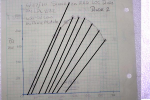Are you talking about this curve?
I completely missed that whole discussion of a new diode.
In short, that is 100% perfectly normal and expected for any and every laser diode. The rollover is 100% caused by heat, and that rollover doesn't happen when pulsing the diode (as pulsing has the effect of removing heating from the equation, not a perfect assumption but good enough). It's not seen in other reds because they die before they get to the point where it rolls over. It's not seen in violet or blue diodes because the material they're made out of (GaN-based materials) is *much* less sensitive to temperature, and they die WAY before they reach the heat/power dissipation required to see the full rollover. The rollover is not intentional, it's not a design feature, and would be completely avoided if at all possible, but that's just what happens when you're running CW and heating a laser (by running it CW, just to clarify) and it hasn't died from other factors yet.
Current, heat, and light all kill, but you can tell which one is doing it by how they behave. COD happens suddenly and all at once when you reach a certain power level, and will happen whether you're running CW or pulsed. Current kills whether you're running CW or pulsed, but generally happens as a slower degradation (and you can test more to confirm it's current-caused degradation). Heat causes this roll-over in performance, and doesn't kill when pulsing, so you can differentiate between heat-caused deaths and other deaths by pulsing the diode. It's more complicated than that, naturally, but that's the idea of how to differentiate between causes of death. Light can cause slow degradation I suppose, but you can still do work to isolate what is causing your diodes to degrade, even if it's just a slow degradation.
----------------------------------------
ETA: Alright I read the whole other thread now, and what I wrote above still stands. The one "pulsed" test on the other thread was 50% duty at 1kHz...that's not CW, but it's not pure pulsed either for the purposes of laser diodes. 50% duty at 1kHz is still enough to produce significant heating. Notice he said the rollover does happen at a higher current than at CW, which makes sense because you are getting LESS heating at that duty cycle, but you are still getting heating. Pulse fast enough to remove the heating (which is basically the working definition of "pulsed" in laser terms, fast enough to remove all effects of heating), and you'll get rid of the rollover completely.





